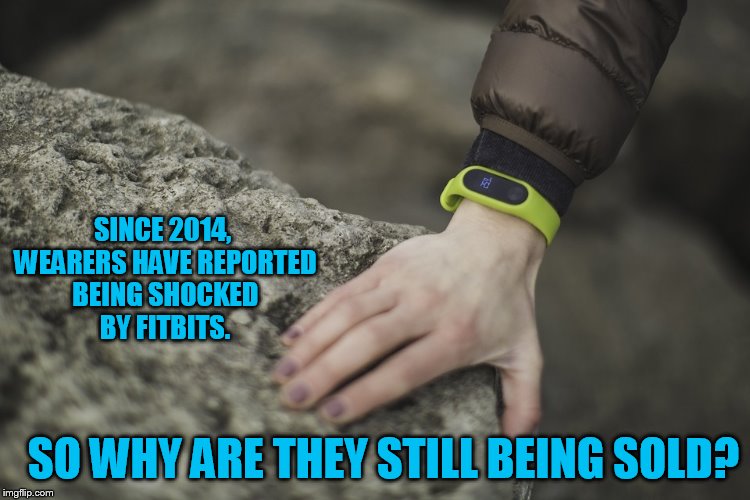(B.N. Frank) Before there were fitness trackers (also known as Activity Trackers) most people didn’t rely on devices to measure their physical activity or the intricate biological details associated with that activity. Increasing one’s physical activity was typically as simple as spending more time being physically active. No expensive measuring trackers required.
Related Sleep and Fitness Go Hand-in-Hand
by B.N. Frank, May 6th, 2022
Fitness trackers and other wireless wearables also expose wearers to biologically harmful Electromagnetic Fields (aka “Electrosmog”), Bluetooth, and wireless “Wi-Fi” radiation. In fact, manufacturers are required to provide warnings about exposure risks for all wireless radiation emitting products as they can and do cause a variety of undesirable symptoms and injuries. Most would agree that deliberately exposing oneself to biologically harmful radiation defeats the purpose of improving ones’ health. Additionally, over the years, there have been numerous lawsuits, recalls, and reports about fitness tracker inaccuracies as well as other issues associated with them, like Fitbits burning wearers. Adding insult to literal injury, newly released research also suggests that despite so many people buying and wearing fitness trackers, there has been a significant decrease in physical activity among people of all ages over the past 25 years.
From The Conversation:
A boom in fitness trackers isn’t leading to a boom in physical activity – men, women, kids and adults in developed countries are all moving less
Worldwide sales of fitness trackers increased from US$14 billion in 2017 to over $36 billion in 2020. The skyrocketing success of these gadgets suggests that more people than ever see some value in keeping tabs on the number of steps they take, flights of stairs they climb, time they spend sitting and calories they burn.
The manufacturers of these devices certainly want consumers to believe that tracking fitness or health-related behaviors will spur them on to increase their activity levels and make them healthier.
Our analysis of research published over the past 25 years suggests otherwise.
We are professors of kinesiology – the science of human body movement – at Boise State, the University of Tennessee and the University of North Florida. To learn whether and how physical activity has changed in the years since fitness trackers became popular, we analyzed more than two decades of research from several industrialized nations – all conducted before the COVID-19 pandemic.
Our systematic review of data from eight developed nations around the world shows that despite the surge in sales of fitness trackers, physical activity declined from 1995 to 2017. What’s more, we discovered that this was not an isolated effect in one or two countries, but a widespread trend.
Reviewing the research
To conduct the study, we first searched for published research that tracked physical activity such as walking, household activities or playing sports throughout the day. We wanted studies that obtained two “snapshots” of daily activity from a population, with the measurements separated by at least one year.
We found 16 studies from eight different countries that met these criteria: Canada, the Czech Republic, Denmark, Greece, Japan, Norway, Sweden and the United States. The studies were conducted between 1995 and 2017.
It is important to note that these snapshots did not track specific individuals. Rather, they tracked samples of people from the same age group. For example, one Japanese study of physical activity among adults ages 20 to 90 collected data each year for 22 years from people in each age group.
Scientists tracked the participants’ physical activity using a variety of wearable devices, from simple pedometers – step counters – to more sophisticated activity monitors like accelerometers.
The study groups ranged from large, nationally representative samples numbering tens of thousands of people to small samples of several hundred students from a few local schools.
After identifying the research studies, we calculated an “effect size” for each study. The effect size is a method of adjusting the data to allow for an “apples-to-apples” comparison. To calculate the effect size, we used the data reported in the studies. These include the average physical activity at the beginning and end of each study, the sample size and a measure of the variability in physical activity. Using a technique called meta-analysis, this allowed us to combine the results of all studies to come up with an overall trend.
We discovered that overall, researchers documented fairly consistent declines in physical activity, with similar decreases in each geographical region and in both sexes. Overall the decrease in physical activity per person was over 1,100 steps per day between 1995 and 2017.
Our most striking finding was how sharply physical activity declined among adolescents ages 11 to 19 years – by roughly 30% – in the span of a single generation. For instance, when we compared the studies reporting physical activity in steps per day, we found the total steps per day per decade declined by an average of 608 steps per day in adults, 823 steps per day in children and 1,497 steps per day in adolescents.
Our study doesn’t address why physical activity has declined over the past 25 years. However, the studies we reviewed mentioned some contributing factors.
More staring at screens, less walking or bicycling
Among adolescents, declines in physical activity were associated with increases in ownership and use of smartphones, tablets, video games and social media.
In the U.S., for example, screen time increased dramatically in adolescents, from five hours per day in 1999 to 8.8 hours per day in 2017.
At school, most of the physical activity that adolescents perform has traditionally come from physical education classes. However, the changes in the frequency of physical education classes during the study period are inconsistent and vary from country to country.
All of these factors may help to explain the decline in physical activity that we observed in our study.
In addition, fewer adults and children are walking or bicycling to school or work than 25 years ago. For instance, in the late 1960s, most U.S. children ages 5 to 14 rode a bicycle or walked to school. Since then, this “active transportation” has largely been replaced by automobile trips. Rates of travel by school bus or public transportation have seen little change.
So why use a fitness tracker?
So if levels of physical activity have dropped at the same time that the popularity of fitness tracking has grown, what makes these gadgets useful?
Fitness trackers can help to increase people’s awareness of their daily physical activity. However, these devices are only part of the solution to addressing the problem of sedentary lifestyles. They are facilitators, rather than drivers, of behavior change.
When a person’s physical activity goes down, it opens the door to overall reduced fitness levels and other health problems such as obesity or diabetes. On the other hand, physical activity has a dramatic positive impact on health and well-being. The first step to increasing active movement is to measure it, which these devices can do. But successfully increasing one’s overall physical activity requires several additional factors such as goal setting, self-monitoring, positive feedback and social support.
In some parts of the world, government agencies are warning residents about radiation exposure from cell phones and other wireless sources. Not in the U.S. though. In 2021, a federal court ruled in favor of organizations and petitioners that sued the Federal Communications Commission (FCC) for NOT adequately protecting Americans from wireless radiation exposure (including 5G). The Food and Drug Administration (FDA) is also supposed to guarantee the safety of cell phones and other radiation-emitting products and infrastructure. That’s not happening either (see 1, 2, 3).
Got pets? Exposure can affect them too.
Stillness in the Storm Editor: Why did we post this?
The news is important to all people because it is where we come to know new things about the world, which leads to the development of more life goals that lead to life wisdom. The news also serves as a social connection tool, as we tend to relate to those who know about and believe the things we do. With the power of an open truth-seeking mind in hand, the individual can grow wise and the collective can prosper.
– Justin
Not sure how to make sense of this? Want to learn how to discern like a pro? Read this essential guide to discernment, analysis of claims, and understanding the truth in a world of deception: 4 Key Steps of Discernment – Advanced Truth-Seeking Tools.
Stillness in the Storm Editor’s note: Did you find a spelling error or grammatical mistake? Send an email to corrections@stillnessinthestorm.com, with the error and suggested correction, along with the headline and url. Do you think this article needs an update? Or do you just have some feedback? Send us an email at sitsshow@gmail.com. Thank you for reading.
Source:
DIRECT DONATION
Support our work! (Avoid Big Tech PayPal and Patreon)



Leave a Reply